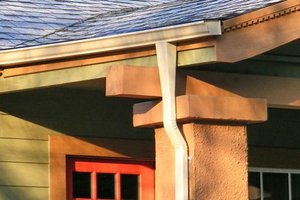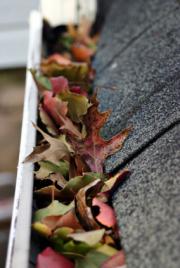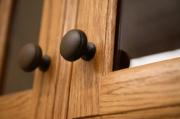
You don’t need to be an inspector to know that puddles in the basement or a lake on the front lawn are signs of drainage trouble. But not all drainage problems are so obvious. Some can be hard to spot unless you know what to look for. Here’s how the pros read seven of the more subtle signs of potential water damage, and why you’ll save big bucks if you tackle these problems now instead of later.
1. Malfunctioning gutters
Rain cascading over the edge of a gutter means that dead leaves and debris are blocking the flow. But that’s not the only sign of malfunctioning gutters. Mud spattered on siding or paint peeling off the house in vertical strips are other indications. If left unchecked, overflowing gutters can rot siding, ruin paint jobs, even cause structural damage.
Best case: Leaves are clogging the downspout, and you just need to clear them out or hire a pro to do it (about $75).
Worst case: Gutters are undersized or improperly pitched and need to be replaced or reinstalled. That could run a few thousand dollars, but it’s still cheaper than new siding.
2. Downspouts that dump
Each inch of rain that falls on 1,000 square feet of a house produces more than 600 gallons of runoff, enough to fill 10 bathtubs to the brim. Dumping that much water too close to the foundation can send it right into the basement, where it can ruin furnishings and flooring and damage mechanical equipment.
Best case: You can add gutter extensions (about $10 for a 10-foot length) to carry the water at least five feet away from the house.
Worst case: The downspouts drop straight down behind large shrubs or other obstacles. An installer may be able to relocate the downspouts (about $150 for each one moved). If not, you’ll need to uproot landscaping to add extensions or underground piping—a sacrifice worth considering if you’ve got water infiltrating the basement.
3. Water stains in the basement
Depending on where the stain appears, you can tell whether the problem is caused by surface water, which can be easy to deal with, or water traveling underground, a more complex situation.
Best case: Stains are high on the foundation wall, indicating that the water is coming (or once came) from an overflowing gutter or surface water directed at the house.
Worst case: The stain extends in a line around the basement, indicating a high-water mark that may recur when heavy rains hit, either because of underground water or because the basement floor lies below the level of municipal storm drains that back up. In that case, an interior drain system and sump pump (around $3,000) are essential for getting the water out if the problem can’t be resolved some other way.
4. Cracks in the foundation
Hairline cracks, as thin as thread, are just cosmetic. Bigger cracks may or may not spell trouble. It depends on the width of the crack, how deep it penetrates, and whether it’s growing.
Best case: A crack appears where the builders finished installing one load of concrete and began pouring the next. Such cracks usually don’t penetrate all the way through. And even if they do, as long as they’re stable you can patch them with hydraulic cement or polyurethane caulk for less than $20.
Worst case: Cracks are continuing to widen, indicating that a drainage problem may be ruining the foundation. Call a structural engineer (not a contractor or waterproofing expert) to diagnose the problem, assess the risk, and suggest a repair.
5. Flaking and deposits on walls
If you see areas of white or gray crust on the basement walls, that’s efflorescence, mineral deposits left behind by evaporating water. Or the wall may be flaking off in big patches, a condition called spalling.
Best case: The efflorescence points to a place where moisture is condensing. It doesn’t cause structural problems, but you may want to scrape off the crust if it looks ugly.
Worst case: The wall is spalling because water is getting inside the masonry. Spalling can be just superficial, but if it’s deep and widespread, it may be a sign of freeze/thaw damage that could progressively weaken the foundation.
6. Mildew in the attic
The attic might seem like a strange place to look for drainage problems, but mildew on the underside of the roof can be a tipoff to serious trouble at the ground level.
Best case: Bathroom fans are spewing hot air directly into the attic, where it condenses on the cold back side of the roof and causes mildew. Venting the fan through an outside wall or the roof (about $200) solves the problem.
Worst case: Moisture from the basement or crawl space is rising through the house and condensing on the underside of the roof. In that case, you’ve got to find and stop the source of the dampness under the house. Then you may have to replace roof sheathing and shingles, a job that runs $6,000 to $9,000 for the typical house.
7. Migrating mulch
When soil doesn’t drain properly, rain may run off in sheets, carving gulleys in the landscape, dumping silt on pathways, and carrying piles of mulch or wood chips where they don’t belong.
Best case: For a few hundred dollars, you can hire a landscaper to create a simple berm (a soil mound) or swale (a wide, shallow ditch) to redirect the water flow away from the house.
Worst case: You notice the problem when your concrete patio cracks, or paving stones start popping up, because the gravel or sand base material has washed away. After redirecting the water, you’ll need to excavate the patio and start again.
Read more: http://www.houselogic.com/articles/drainage-warning-sides/#ixzz1Ymku9vbH

 You don’t need to be an inspector to know that puddles in the basement or a lake on the front lawn are signs of drainage trouble. But not all drainage problems are so obvious. Some can be hard to spot unless you know what to look for. Here’s how the pros read seven of the more subtle signs of potential water damage, and why you’ll save big bucks if you tackle these problems now instead of later.
You don’t need to be an inspector to know that puddles in the basement or a lake on the front lawn are signs of drainage trouble. But not all drainage problems are so obvious. Some can be hard to spot unless you know what to look for. Here’s how the pros read seven of the more subtle signs of potential water damage, and why you’ll save big bucks if you tackle these problems now instead of later. Lubricate locks and hinges: Creaky hinges and sticking locks can spook you at exactly the wrong moment, so make the rounds with a can of WD-40. It’ll clean and lubricate metal mechanisms in one shot.
Lubricate locks and hinges: Creaky hinges and sticking locks can spook you at exactly the wrong moment, so make the rounds with a can of WD-40. It’ll clean and lubricate metal mechanisms in one shot. Quiet kitchen cabinets: Before the Fall is over, your kitchen will soon be bustling with holiday dinners, baking projects, and house guests, so don’t let little annoyances get in the way of big plans. Clean and lubricate drawers and hinges on kitchen cabinets, and replace any catches that no longer catch.
Quiet kitchen cabinets: Before the Fall is over, your kitchen will soon be bustling with holiday dinners, baking projects, and house guests, so don’t let little annoyances get in the way of big plans. Clean and lubricate drawers and hinges on kitchen cabinets, and replace any catches that no longer catch.
